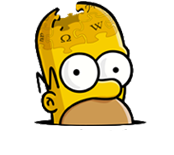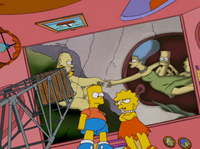
Difference between revisions of "The Homer of Seville/References"
Wikisimpsons - The Simpsons Wiki
Solar Dragon (talk | contribs) |
Solar Dragon (talk | contribs) |
||
| Line 3: | Line 3: | ||
== Cultural references == | == Cultural references == | ||
| − | [[File: | + | [[File:The Creation of Adam.png|thumb|right|Homer painting a parody of Michelangelo's ''The Creation of Adam''.]] |
*The episode title is a reference to the {{w|Gioachino Rossini|Rossini}} opera ''{{w|The Barber of Seville}}''. | *The episode title is a reference to the {{w|Gioachino Rossini|Rossini}} opera ''{{w|The Barber of Seville}}''. | ||
*The [[chalkboard gag]] mentions ''{{W|The Wall Street Journal}}''. | *The [[chalkboard gag]] mentions ''{{W|The Wall Street Journal}}''. | ||
Revision as of 07:41, December 9, 2019
|
|||||||||
|
|
|
Contents
Cultural references
- The episode title is a reference to the Rossini opera The Barber of Seville.
- The chalkboard gag mentions The Wall Street Journal.
- The marquee outside the church calls Jesus the Real American Idol.
- Griddler on the Roof is a reference to the musical Fiddler on the Roof.
- T.G.I. Fried Eggs is a reference to the restaurant chain TGI Fridays.
- Luftwaffles is a reference to the Luftwaffe, the aerial warfare branch of the German Wehrmacht during World War II.
- Buffet the Hunger Slayer is a reference to Buffy the Vampire Slayer.
- Homer mentions the restaurant chain Denny's.
- Bart calls Mahogany a great movie.
- Lisa claims that tenor Andrea Bocelli recorded an entire song on his back. Bocelli apparently did record one track on his Amore album on his back, and demonstrated this technique on an episode of American Idol.
- Homer sings "If Ever I Would Leave You" from the musical Camelot.
- Homer stars in the opera La bohème.
- The Springfield Opera House is shaped like the Sydney Opera House.
- The scene of Lenny and Carl watching Homer's opera performance from the rafters is a reference to a similar scene in Citizen Kane.
- During the opera montage, Swan Lake, "Op.20: Act I- No.5 Pas de deux: I Tempo di valse ma non troppo vivo, quasi moderato" by Pyotr Ilyich Tchaikovsky plays.
- Homer sings "The Star-Spangled Banner" by Francis Scott Key, the national anthem of the USA.
- Homer says that Plácido Domingo is his third favorite of The Three Tenors.
- Homer's entourage, Lenny and Carl, is a parody of the HBO series Entourage. The music when Lenny (who dresses like Turtle) and Carl are in the limousine is the show's theme song, "Superhero" by Jane's Addiction.
- When Carl and Lenny are sent away from the table at The Gilded Truffle, Carl mutters "Yoko", at Marge. It is a reference to Yoko "breaking up The Beatles", but in this case Marge is breaking up the entourage.
- When Julia takes her helmet off to reveal that she's a female biker, Homer asks if this is The Twilight Zone.
- Marge makes Chex Mix pie.
- The orchestral sequence featured in the cobra scene is the overture of Mozart's opera Don Giovanni.
- Homer stars in The Barber of Seville.
- Homer sings the song "Se il mio nome saper voi bramate" from the opera.
- The line about the chandelier being pre-crashed is a reference to a famous scene from The Phantom of the Opera.
- Marge mentions conductor Arthur Fiedler.
- Homer paints a parody of Michelangelo's The Creation of Adam on the ceiling.
- Chief Wiggum calls Julia "Hagliacci", a reference to the opera Pagliacci, and "Madame Butterface", a reference to the opera Madama Butterfly.
Trivia
- Restaurants spotted or mentioned after the family leaves church: Griddler on the Roof, Thank God It's Fried Eggs, Luftwaffle's, Bodacious Frittatas, Buffet the Hunger Slayer, and Denny's.
Continuity
- When Homer forgets his lines he sings "Uh-oh Spaghetti-os"? This was the catch phrase of the fictional police officer Homer Simpson in the season 10 episode "Homer to the Max".
Goofs
- When Burns and Smithers are "shopping" at the morgue, a sign on the wall says "HOSPTIAL MORGUE".
- Carl and Lenny are shown in the rafters commenting about how their "seats are terrible." However, after the performance ends, Carl and Lenny can be seen in the audience as they give Homer a standing ovation (top right quadrant).
- Rodolfo is referred to as "Rudolfo" on the translation during La bohème.

